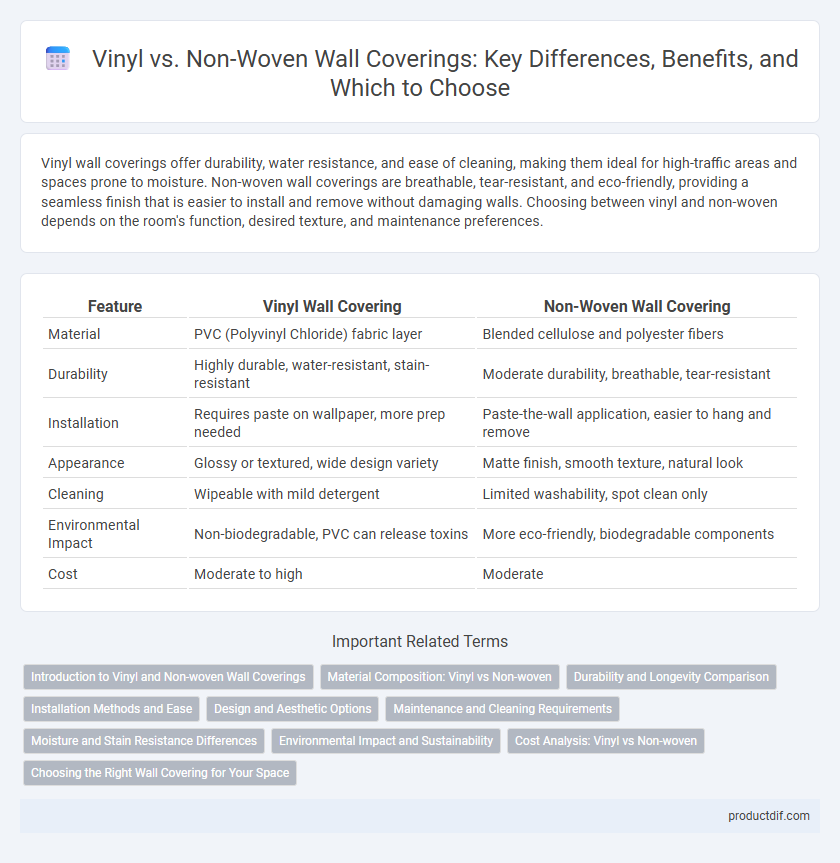Vinyl wall coverings offer durability, water resistance, and ease of cleaning, making them ideal for high-traffic areas and spaces prone to moisture. Non-woven wall coverings are breathable, tear-resistant, and eco-friendly, providing a seamless finish that is easier to install and remove without damaging walls. Choosing between vinyl and non-woven depends on the room's function, desired texture, and maintenance preferences.
Table of Comparison
| Feature | Vinyl Wall Covering | Non-Woven Wall Covering |
|---|---|---|
| Material | PVC (Polyvinyl Chloride) fabric layer | Blended cellulose and polyester fibers |
| Durability | Highly durable, water-resistant, stain-resistant | Moderate durability, breathable, tear-resistant |
| Installation | Requires paste on wallpaper, more prep needed | Paste-the-wall application, easier to hang and remove |
| Appearance | Glossy or textured, wide design variety | Matte finish, smooth texture, natural look |
| Cleaning | Wipeable with mild detergent | Limited washability, spot clean only |
| Environmental Impact | Non-biodegradable, PVC can release toxins | More eco-friendly, biodegradable components |
| Cost | Moderate to high | Moderate |
Introduction to Vinyl and Non-woven Wall Coverings
Vinyl wall coverings consist of a durable synthetic material known for its moisture resistance and easy maintenance, making it ideal for high-traffic areas and humid environments. Non-woven wall coverings are made from a blend of natural and synthetic fibers, offering breathability, tear resistance, and simple installation without the need for soaking. Both types provide diverse design options, but vinyl excels in durability while non-woven emphasizes eco-friendliness and ease of use.
Material Composition: Vinyl vs Non-woven
Vinyl wall coverings are composed of a polyvinyl chloride (PVC) surface layer, often backed by fabric or paper, providing durability, moisture resistance, and easy maintenance. Non-woven wall coverings consist of a blend of natural and synthetic fibers, typically cellulose and polyester, resulting in a breathable, tear-resistant material that facilitates easier installation and removal. The choice between vinyl and non-woven materials influences wall covering performance in terms of flexibility, longevity, and environmental impact.
Durability and Longevity Comparison
Vinyl wall coverings offer superior durability and resistance to moisture, making them ideal for high-traffic or humid areas such as kitchens and bathrooms. Non-woven materials, while breathable and easier to install or remove, generally have lower abrasion resistance and may wear out faster in heavily used spaces. Vinyl's water-resistant properties significantly enhance its longevity compared to non-woven options, which can be prone to tearing and fading over time.
Installation Methods and Ease
Vinyl wall coverings typically require a paste-the-wall installation method, where adhesive is applied directly to the wall, offering straightforward alignment and repositioning during application. Non-woven wallpapers allow for a paste-the-wall or direct-paste method, making them highly user-friendly and less prone to bubbling or stretching. Both materials provide durable options, but non-woven finishes often simplify removal, reducing wall damage and cleanup time.
Design and Aesthetic Options
Vinyl wall coverings offer a wide range of vibrant colors, intricate patterns, and textured finishes, making them ideal for high-traffic areas requiring durable yet stylish surfaces. Non-woven wall coverings provide a more natural, fabric-like appearance with subtle textures and matte finishes, enhancing sophisticated and modern interiors. Both materials support diverse design aesthetics, but vinyl excels in bold, washable designs while non-woven emphasizes elegance and ease of application.
Maintenance and Cleaning Requirements
Vinyl wall coverings are highly durable and resistant to moisture, making them easy to clean with mild soap and water, suitable for high-traffic or humid areas. Non-woven wall coverings, while breathable and tear-resistant, require gentler cleaning methods such as light vacuuming or spot cleaning with a damp cloth to maintain their texture and appearance. Proper maintenance of vinyl ensures longevity in kitchens or bathrooms, whereas careful upkeep of non-woven helps preserve their decorative qualities in living spaces.
Moisture and Stain Resistance Differences
Vinyl wall coverings excel in moisture and stain resistance due to their impermeable surface, making them ideal for high-humidity areas such as kitchens and bathrooms. Non-woven wall coverings, composed of synthetic fibers, offer moderate moisture resistance but tend to absorb stains more readily compared to vinyl. The enhanced durability of vinyl against water damage and spills significantly outperforms non-woven materials, ensuring longer-lasting aesthetic appeal in moisture-prone environments.
Environmental Impact and Sustainability
Vinyl wall coverings often contain PVC and plasticizers, contributing to environmental pollution and limited recyclability, whereas non-woven wall coverings use natural fibers or biodegradable materials, enhancing sustainability and reducing landfill waste. Non-woven materials typically allow for better breathability and lower emissions of volatile organic compounds (VOCs), supporting healthier indoor air quality. Selecting non-woven options aligns with eco-friendly building certifications like LEED, emphasizing resource efficiency and reduced environmental footprint.
Cost Analysis: Vinyl vs Non-woven
Vinyl wall coverings typically cost between $1 to $5 per square foot, offering durability and moisture resistance suitable for high-traffic or humid areas, while non-woven options range from $2 to $7 per square foot, providing easier installation and better breathability. Maintenance expenses for vinyl are generally lower due to their wipeable surface, whereas non-woven materials may require more careful cleaning to preserve texture and appearance. Budget considerations should include not only initial purchase price but also long-term upkeep and environmental factors influencing overall cost-effectiveness.
Choosing the Right Wall Covering for Your Space
Vinyl wall coverings offer durable, moisture-resistant surfaces ideal for high-traffic or humid areas such as kitchens and bathrooms. Non-woven wall coverings, composed of synthetic and natural fibers, provide breathability and easy installation with a seamless finish, making them suitable for living rooms and bedrooms. Selecting the right wall covering depends on factors like room usage, moisture levels, and desired texture to balance aesthetics and functionality effectively.
Vinyl vs Non-woven Infographic

 productdif.com
productdif.com